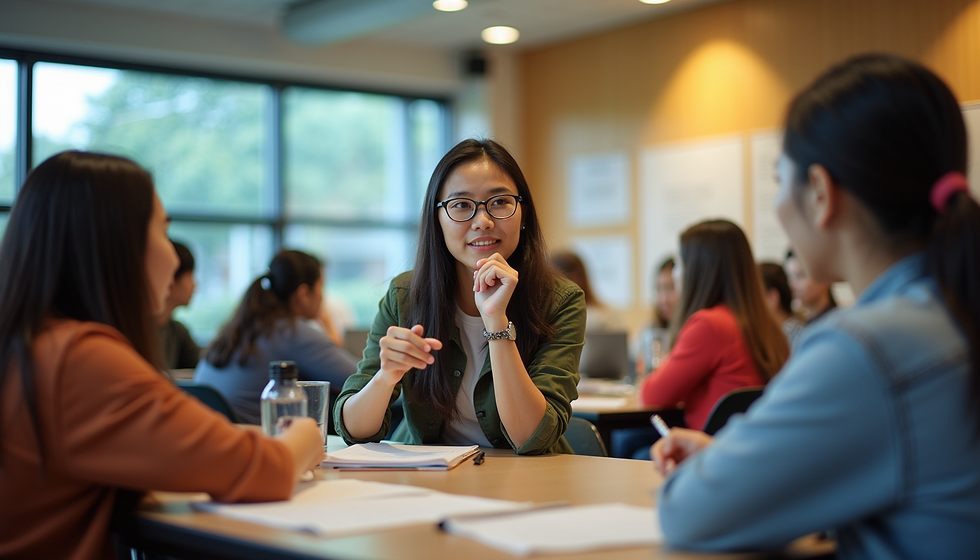Strategies to Empower Educators for Better Learning Outcomes
- USA Student Advisory
- Jun 14
- 4 min read
In today’s educational landscape, the role of educators has evolved significantly. Gone are the days when teachers were mere transmitters of knowledge. Today, they are facilitators of learning, mentors, and innovators. This blog post explores effective strategies that can empower educators to enhance teaching outcomes and foster better learning experiences for students.
Teaching Strategies to Enhance Educator Effectiveness
Effective teaching strategies are essential to improve student engagement and learning outcomes. Empowering educators is about providing them with the tools and knowledge to implement these strategies successfully. Here are some tried-and-true methods:
Professional Development Programs: Continuous growth is crucial for educators. Professional development opportunities allow teachers to learn new strategies, share experiences, and collaborate with peers. Workshops, seminars, and online courses are excellent ways to enhance teaching skills. According to a study by the National Staff Development Council, schools that support teacher learning see improved student performance.
Use of Technology in the Classroom: Incorporating technology can transform teaching and make learning more interactive. Educators should be encouraged to use digital tools and resources that foster engagement. For example, platforms like Google Classroom and educational apps can help teachers track student progress and facilitate collaboration among students.

Collaborative Learning Environments: Creating a culture of collaboration among teachers can positively affect student learning. Teacher teams can share best practices, develop lesson plans together, and provide mutual support. Collaboration breeds innovation and encourages risk-taking among educators, leading to better solutions for challenges faced in the classroom.
Differentiated Instruction for Diverse Learners
Every student has unique learning needs, and differentiated instruction is key to addressing these differences. Educators can empower themselves to cater to various learning styles and abilities by applying the principles of differentiated instruction:
Assess Learning Styles: Understanding students' learning preferences is vital. Tools like learning style inventories can help educators identify how their students learn best. Once they understand these preferences, educators can tailor their instructional methods accordingly, ensuring that each student can engage effectively with the material.
Offer Flexible Grouping: Organizing students into various groups based on their abilities and interests can lead to better learning outcomes. Teachers should consider grouping students for collaborative projects and activities, enabling peer support and diverse perspectives. This approach not only empowers educators but also fosters a sense of community in the classroom.

Culturally Responsive Teaching
Culturally responsive teaching (CRT) recognizes the importance of including students' cultural references in all aspects of learning. Empowering educators to embrace CRT can lead to more inclusive classrooms where all students feel valued:
Learn About Students’ Backgrounds: Teachers should take the time to understand the cultural backgrounds of their students. This knowledge can inform lesson planning and create connections between the curriculum and students’ lived experiences. Including culturally relevant materials and topics can lead to increased engagement and motivation.
Inclusive Curriculum Design: Educators need to ensure that the curriculum reflects diverse perspectives and voices. This can help students see themselves in the material they study. For instance, including literature from various cultures and encouraging discussions about social justice can empower students to think critically and appreciate diversity.
Building a Growth Mindset in Educators
A growth mindset is essential for educators who want to continually improve and adapt. Emphasizing this mindset among teachers can lead to better outcomes for both educators and students:
Encourage Risk-Taking: Schools should create an environment where educators feel safe to experiment with new techniques. By encouraging them to take risks and learn from failures, schools can foster innovation and creativity. This mindset can be contagious, inspiring students to embrace challenges in their learning journeys.
Professional Learning Communities (PLCs): Establishing PLCs within schools can facilitate peer support and collective growth. Educators can meet regularly to share insights, discuss challenges, and brainstorm solutions. Research shows that teachers who participate in PLCs report higher levels of job satisfaction and effectiveness.

Leveraging Data for Informed Decisions
Data-driven decision-making is a powerful tool for educators. By analyzing student performance and other relevant data, teachers can identify areas for improvement and adjust their strategies accordingly:
Regular Assessments: Implementing regular assessments helps teachers understand student progress and identify learning gaps. Educators can use formative assessments to adapt instruction in real-time. This practice not only empowers teachers but also provides critical feedback to students on their learning.
Actionable Insights: Data should be used to inform instructional planning. Instead of merely collecting data, teachers should focus on deriving actionable insights that can lead to specific improvements in their teaching strategies. For instance, if data shows a decline in performance in a particular subject area, educators can seek additional resources or training in that area.
Fostering Strong Relationships with Students
The relationship between educators and their students significantly impacts learning outcomes. Empowering teachers to build these relationships can create a more conducive learning environment:
Show Genuine Interest: Encouraging educators to show genuine interest in their students’ lives can foster trust and respect. Simple gestures like asking about students' hobbies or their weekend can go a long way in building rapport.
Provide Support and Encouragement: Educators should be trained to provide emotional support to their students. Acknowledging students' efforts, celebrating their achievements, and offering encouragement can help develop resilience and a positive outlook toward learning.
Incorporating these strategies can significantly transform the educational experience for both teachers and students. Educators play a pivotal role in shaping the future, and by empowering them with the right tools and mindset, we can create a thriving learning environment where all learners can succeed.
Empowering Educators: A Collective Responsibility
Empowering educators is not just the responsibility of schools and institutions; it is a collective effort that involves communities, policymakers, and educational leaders. By investing in the professional development of teachers, embracing cultural diversity, and promoting innovative teaching strategies, we can ensure that educators are well-equipped to foster better learning outcomes for all.
As education continues to evolve, let us commit to supporting our educators through strategies that enhance their skills and enrich the learning experience for every student.











Comments